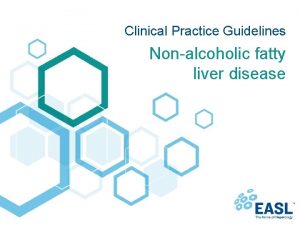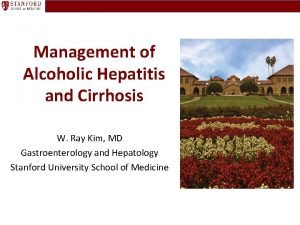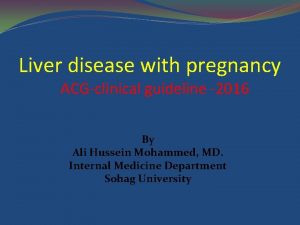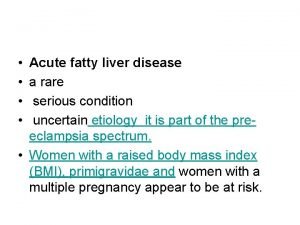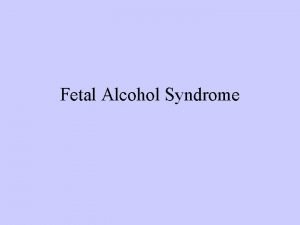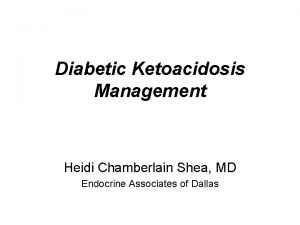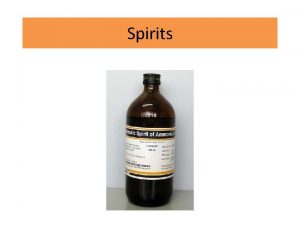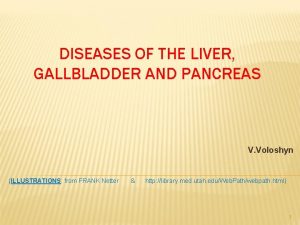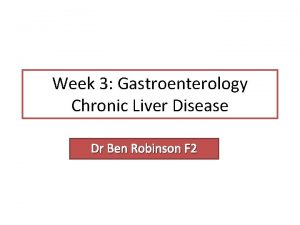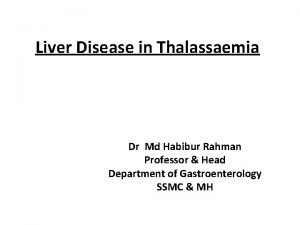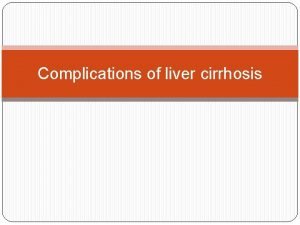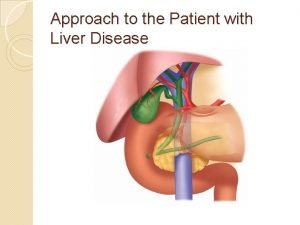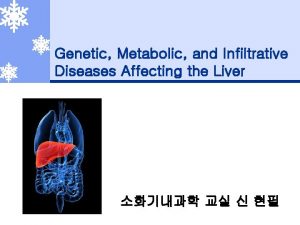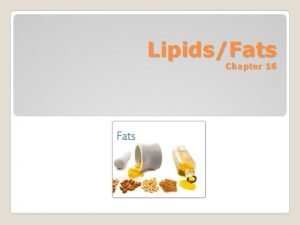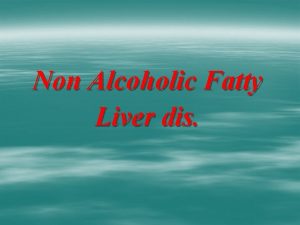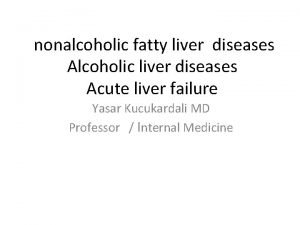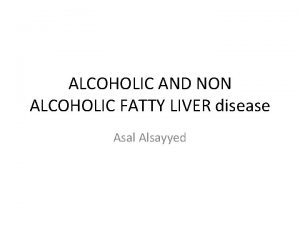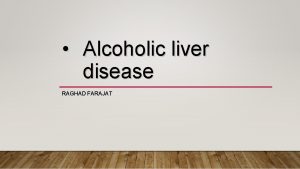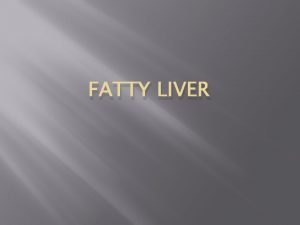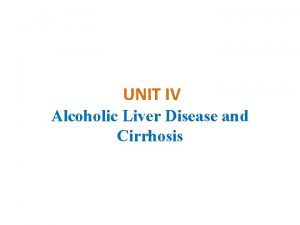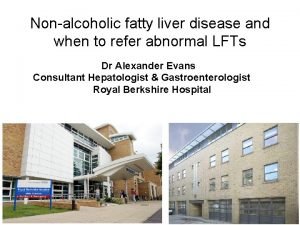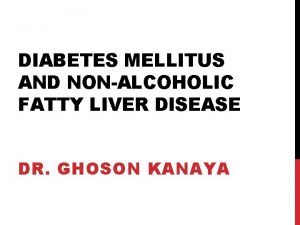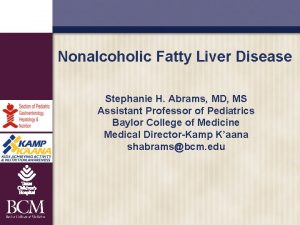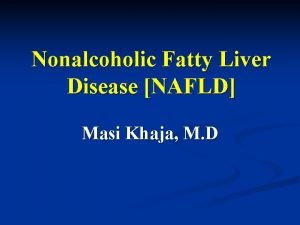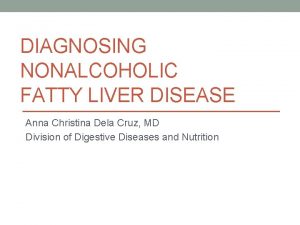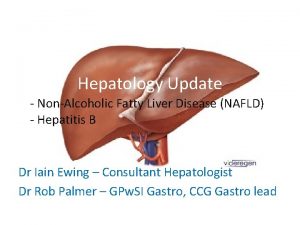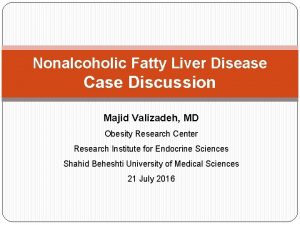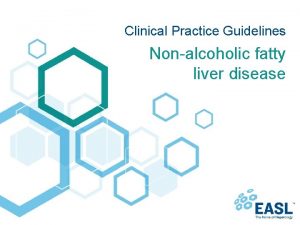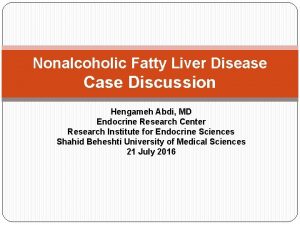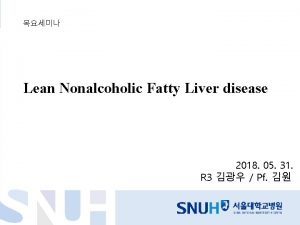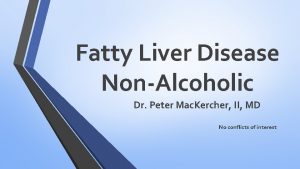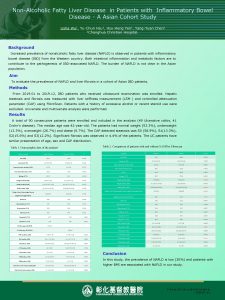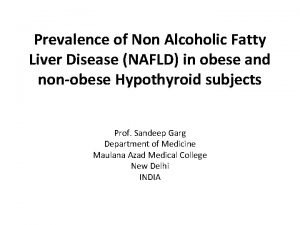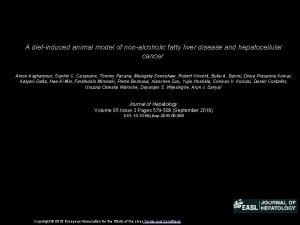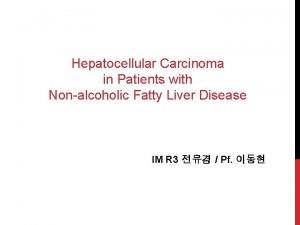Alcoholic liver disease and nonalcoholic fatty liver disease



























- Slides: 27

Alcoholic liver disease and non-alcoholic fatty liver disease Dr. Abdulwahhab S. Abdullah CABM, FICMS-G&H

Alcoholic liver disease • Alcoholic liver disease (ALD) is one of the most common causes of chronic liver disease worldwide. • The dose and duration of alcohol intake is the most important factor in the development of ALD. • The threshold for developing ALD is variable but begins at 20 g/day in women and 30 g/day in men. • Only 10 -20% of those who drink heavily will develop cirrhosis, so a genetic predisposition is likely.

½b d / e l ott ½ = ay x 8 2 x 2 1 1 8= y a d g/

So, what are the risk factors for ALD? Amount and duration of alcohol intake. Drinking pattern: continuous > ‘binge’ drinkers. Gender: women > men (gastric enzyme) Genetics: susceptibility genes (e. g. PNPLA 3), mild phenotypes of other chronic liver diseases (e. g. HFE gene heterozygote, MZ α 1 -antitrypsin phenotype). • Co-existent chronic viral hepatitis particularly HCV. • Nutrition: obesity and malnutrition. • •

How is alcohol metabolized? alcohol Alcohol dehydrogenase MEOS (CYP 2 E 1) Aldehyde dehydrogenase MEOS: microsomal ethanol-oxidizing system CYP 2 E 1: cytochrome P 450 2 E 1 isozyme acetaldehyde acetate

What is the pathophysiology of alcoholic liver injury?

© 2006 The Authors, Aliment Pharmacol Ther 24, 1151– 1161

What are the clinical and histopathological features of ALD?

Three distinct clinico-pathological entities of ALD are recognized:

What are the investigation findings in ALD? • Alcoholic fatty liver: CBC: ↑MCV US: bright liver LFTs: ↑AST&ALT, ↑GGT Liver biopsy: simple steatosis • Alcoholic steatohepatitis: CBC: ↑WBC (neutrophils) LFTs: ↑bilirubin, ↑AST&ALT, ↑ALP, ↑PT, ↓albumin Liver biopsy: same as non-alcoholic steatohepatitis • Alcoholic cirrhosis:

How to manage patients with ALD? • General (all patients): Life-long abstinence is most important diazepam can be used for withdrawal symptoms Nutrition is important as malnutrition is common • Alcoholic fatty liver: just as above • Alcoholic cirrhosis: as for cirrhosis in general but abstinence improves prognosis and slows disease progression

How to manage patients with ALD? • Alcoholic hepatitis: Severe cases require hospital admission Nutrition maintained with enteral feeding if necessary Thiamine given iv to prevent Wernicke encephalopathy Corticosteroids improve severe cases defined by a discriminant function (DF) > 32; DF = [4. 6 × ∆PT sec] + bilirubin (mg/d. L) Pentoxifylline may be used in severe cases if steroids are contraindicated (sepsis, GI bleeding, uncontrolled diabetes)

What about liver transplantation for ALD? • In many transplant centers, decompensated alcoholic cirrhosis is a common indication for LT. • A period of abstinence of 6 months before considering LT is usually required. • LT for alcoholic hepatitis has a poor outcome and is seldom performed.

Non-alcoholic fatty liver disease (NAFLD) • NAFLD refers to the accumulation of fat within hepatocytes that results from insulin resistance. • NAFLD is now recognized as the most common chronic liver disease in the Western world. • NAFLD encompasses a spectrum of disease starting from simple hepatic steatosis, which is generally benign, to nonalcoholic steatohepatitis (NASH), which can progress to cirrhosis, liver failure, and HCC.

Who is at risk of NAFLD? • NAFLD is strongly associated with obesity, dyslipidemia, hypertension, insulin resistance and type 2 diabetes mellitus, and is considered to be the hepatic manifestation of the metabolic syndrome. • NAFLD is also associated with polycystic ovary syndrome, obstructive sleep apnea and smallbowel bacterial overgrowth.

How common is NAFLD? • A large European study found NAFLD in: 94% of obese persons (BMI >30) 67% of overweight persons (BMI >25) 25% of normal-weight persons • In type 2 diabetes, 40 -70% of patients has NAFLD. • NASH was found in up to 16% of apparently healthy potential living liver donors.

metabolic syndrome steatosis NASH The spectrum of non-alcoholic fatty liver disease.

What is the pathophysiology of NAFLD? • Insulin resistance cause an imbalance between import/synthesis and export/catabolism of fatty acids in the liver leading to steatosis. • Hepatocyte injury may then be caused by oxidative stress produced by fatty acid oxidation, direct lipotoxicity, gut-derived endotoxemia, cytokine release, and endoplasmic reticulum stress. • Immune-mediated hepatocellular injury and cell death may ensue leading to stellate cell activation and hepatic fibrosis.

Why do some patients develop progressive NASH while others do not? • As with many other liver diseases, subtle interpatient genetic variations and environmental factors interact to determine disease progression. • As in alcoholic liver disease, PNPLA 3 and its product, adiponutrin, may influence NAFLD severity.

What are the clinical features of NAFLD? • Most patients are asymptomatic and identified by incidental abnormal LFTs. • Some patients may complain of fatigue and mild right upper quadrant discomfort. • Hepatomegaly is commonly found on physical examination.

How to diagnose NAFLD? • Exclude excess alcohol intake and other chronic liver diseases (including viral, autoimmune and other metabolic causes) • Confirm the presence of NAFLD, differentiate simple steatosis from NASH and determine the extent of hepatic fibrosis. • Liver biopsy is the standard for the diagnosis of NASH and assessing hepatic fibrosis but it is invasive and has low patient acceptability.

What are the lab findings in NAFLD? • LFTs: mild ↑ALT&AST and AST: ALT ratio <1 (ALT↓ as fibrosis↑ and AST: ALT ratio reverses (>1) as cirrhosis develops). • Other lab abnormalities: non-specific ↑GGT low-titer ANA in 20 -30% of patients ↑ferritin levels

What are the radiological findings in NAFLD? • Ultrasound: a bright liver usually indicates steatosis but this is not a sensitive finding. • CT, MRI, MR spectroscopy: more sensitive than US but are expensive and not widely available. • No imaging modality can yet distinguish simple steatosis from steatohepatitis or reliably quantify pre-cirrhotic liver fibrosis.

What are the liver biopsy findings in NAFLD and are there any “specific” changes?


How to manage a patient with NAFLD? • Focus on patients with NASH, not simple steatosis. • Weight loss (7– 10% of BW), exercise, strict control of hypertension, diabetes and lipid levels are the only treatments currently available. • Vitamin E, metformin, glitazones, and other drugs were used with little or no benefit. • LT is reserved for decompensated cirrhosis but NAFLD can recur in the allograft.

Thank you
 Stigmata of chronic liver disease
Stigmata of chronic liver disease Non-alcoholic fatty liver disease (nafld)
Non-alcoholic fatty liver disease (nafld) Alcoholic liver disease
Alcoholic liver disease Acute fatty liver of pregnancy
Acute fatty liver of pregnancy Acute fatty liver of pregnancy
Acute fatty liver of pregnancy Lchad deficiency
Lchad deficiency Division of alcoholic beverages and tobacco
Division of alcoholic beverages and tobacco Lesbian symbol in genogram
Lesbian symbol in genogram Alcoholic brain vs normal brain
Alcoholic brain vs normal brain Alcoholic ketoacidosis
Alcoholic ketoacidosis Alcoholic fermentation steps
Alcoholic fermentation steps Turkish alcoholic beverages
Turkish alcoholic beverages Turpentine emulsion preparation
Turpentine emulsion preparation Spirit is
Spirit is What is alcoholic fermentation
What is alcoholic fermentation Alcoholic hepatitis
Alcoholic hepatitis Was edgar allan poe an alcoholic
Was edgar allan poe an alcoholic Gastroenterology board review
Gastroenterology board review Stigmata of chronic liver disease
Stigmata of chronic liver disease Complication of liver cirrhosis
Complication of liver cirrhosis Stigmata of portal hypertension
Stigmata of portal hypertension Peripheral stigmata of cld
Peripheral stigmata of cld Portal hypertension symptoms
Portal hypertension symptoms Stage 3 liver cirrhosis
Stage 3 liver cirrhosis Gennifer shafer liver disease
Gennifer shafer liver disease Infiltrative liver disease
Infiltrative liver disease Bharathi viswanathan
Bharathi viswanathan What are triglycerides
What are triglycerides

